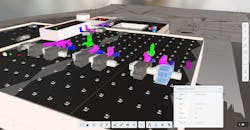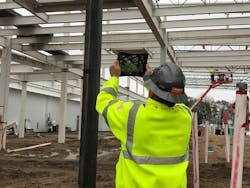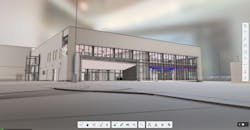Define Your Competitive Advantage Through BIM 360
According to Business Insider, during the first week of April 2020, as a result of the need to contain the COVID-19 threat, approximately 297 million people, or about 90% of the US population were impacted by some kind of stay-at-home or shelter-in-place order. As a result, the ability to work remotely has become a critical business requirement. While the benefits of a BIM 360 application are wide-ranging, among the strongest advantages is evidence in the enhanced collaboration and accessibility the application now makes possible.
The manufacturing industry today is experiencing the impact of this application, but any market sector where prefabrication and modularization are taking hold will also receive the benefits and are building app integration to manage the supply chain and model-component collaboration.
One of the features of the BIM 360 cloud-hosted environment is that it allows project team leaders to set permissions allowing various access levels for different users to view, edit, or author the content based on their role in the project.
Because of the collaboration and accessibility of the platform, all stakeholders know what is happening in real-time and it is now much easier to capture consensus and sign-off at every phase of the project.
Projects are thriving because of this platform technology. BIM 360 is gaining traction in the AEC as AEs, GCs, and owners implement it.
Real-life Applications
Collaboration application eliminates effort.
Using traditional project execution, project teams would generate a set of documents for the top stakeholders to review and sign off at various stages, such as 30/60/90% of completion.
The effort required to prepare, transfer, and track these documents, comments, and signatures literally disappear when a collaborative application like BIM 360 handles not only the data but also the formal handoffs—which simply become less critical when design teams have access to an up-to-date BIM and project documentation.
Experiencing space virtually enhances functionality.
The accessible 3D visual environment also prevents issues in the field late in the project.
Consider a recent industrial facility example. Necessary cross-bracing was unexpectedly visible through an executive’s office window but was too costly to move, resulting in a last-minute reshuffling to repurpose that space and find a new location for the office.
Clearance and maintenance areas around equipment also offer another example.
In many cases, the path of travel around a piece of equipment appears accessible in the initial specification but—in reality—is too tight for maintenance and sometimes even installation depending on the sequence of being constructed.
This often happens for mechanical and electrical rooms, which tend to be limited in size from the project outset.
These are often the spaces that get downsized to make room for other needs, but the accessibility of these spaces is most critical in the coordination of multiple trades.
The ability to experience the spaces virtually and adjust processes to enhance their use reduces risk and instills more confidence in the stakeholders who are providing their buy-in to the plans.
Process changes optimize BIM 360.
Process changes are important to take full advantage of the technology. We all can relate to this in our daily lives that if technology truly provides value the person inherently changes how they are receiving, transmitting or communicating information. People wear smartwatches or devices to capture data to share with other sources or to be notified of a need or action. Many of these digital platforms offer the same data transaction and efficiency opportunity.
Stakeholders who continue to perform handoffs in the traditional project process will have the enhanced visibility the new technology offers, but will not receive the downstream benefit associated with a fully functional collaborative environment.
One of these benefits is the tracking functionality that is built into a BIM 360 environment.
In one example for an industrial project, team leaders were working with a third-party transferring files to coordinate within their own networks.
In addition to the cost of addressing deviations, the project was funding the efforts to transfer 2D and 3D files back and forth instead of letting the system do that automatically.
When BIM 360 collaboration tools are optimized, the project gains efficiency through data exchange just in time, with an “@ mention” or assignment to another team member or project stakeholder within the app, not a formalized handoff via email that may be logged into an action list.
Communication is tracked within the app and there is no need to manually create a log to distribute weekly as it is maintained and accessible through the life of the project.
Data volume enhances efficiency.
The volume of data this technology manages considerably enhances efficiency.
Some projects have over 10,000 drawings that are accessible to project team members in the field.
The data management capabilities are so robust that it took approximately three days to activate the site, set permissions, put iPads in the field, upload all the data, and digitize accessibility for all the various parties. The bottleneck was the Wi-Fi accessibility for the ipads to get the large data set last minute in place.
Because all the data is centrally stored, project teams no longer have multiple paper sets of drawings to keep track of and the text inside the documents is searchable, which makes the volume manageable.
The next logical step in making this leaner will be an organic shift as more stakeholders become comfortable working directly with the model, reducing the need for so many drawings altogether. Increased model quality and deliverables, as well as improved model viewing on mobile devices, will make this a reality. The 3D – 2D side by side offers design and construction teams enhanced context and design intent understanding.
Transparency + Accountability
Centralized storage drives meaningful feedback.
Centralized storage is a key asset facilitating enhanced communication and immediate transmittal of the latest changes so that no stakeholders nor project team members are ever accessing outdated data.
Top stakeholders understandably have varying levels of technical experience and hands-on interest.
Those who are extremely knowledgeable and involved can have access to the latest data, so they always know the current status of their project.
Review meetings glide smoothly when all stakeholders and project team members know the status of the project and can immediately start offering meaningful contextual feedback.
Automatic accountability.
For leaders who are less directly involved, the simple 3D capability gives them an advantage in terms of visualizing the final output.
Reduced permissions for those who are not actively designing or authoring ensures nothing will be changed inadvertently.
Accountability is instantaneous with a system that automatically tracks comments, actions, and issues—everyone knows who is responsible for specific action items, which becomes key when a resolution is needed.
Communication more rapid than email.
Collaborative tools like BIM 360 are inherently changing the way project teams communicate.
The switch from hard copy and physical signatures to PDF files and electronic signatures with email transmittal enhanced traceability in many ways but didn’t change the process so much as the delivery method.
Now, the collaboration apps provide issue tracking, digitized communication, and chat-style communication that moves more rapidly than email.
Early adopters are now considering what process changes they can make and one of the biggest adoption challenges is deciding which handoffs need to remain formalized and which can be streamlined.
Ownership in question.
One of the other challenges with the new technology and methods is the ownership around these collaboration hubs. Individual project team members and team firms may be involved, in some capacity, in multiple BIM 360 hubs including the ones they are responsible for and many are asking the question, “Who owns what data?”
What restrictions are placed on the access that is granted to others and how teams are adjusting their contract language to accommodate collaboration and safeguard themselves, in turn, are now at the forefront.
The other big question is when drawings and other deliverables are “released” and how active, working documents can be used. In the past, the formalized handoff served as an official release and there must be some new process to simulate that level of formality in the collaborative structure.
Looking Forward and around
Panelized prefab is driving BIM 360 evolution.
As panelized prefab and other modular construction methods increase, the collaborative powers of BIM 360 and the Forge data environment become even more important.
Third-party technology companies are building integrations to empower responsible players for preparing the modular pieces essentially building a kit of parts that are then used to build out the design.
The visualization with modeling lends itself to off-site fabrication and the coordination afforded by BIM, a common data environment, as well as the web interface means the integration can begin long before the modules themselves are delivered.
Interfacing with the technological ecosystem.
Keeping the activity within the BIM 360 platform centralizes the data and the forge APIs promote third-party applications to enhance the interface with the data that sits in the platform.
It is easier at that juncture to transfer the data down the supply chain, connecting the REVIT model to fabrication data and using additional plug-ins to create fabrication level deliverables that can be disseminated to production and then to installation.
There is a whole ecosystem of related applications providing a collaboration platform for all key stakeholders—from owners and engineers to contractors, supply chain, and others—to connect to the data.
Today, leaders can define their competitive advantage through maximizing the benefits and potential of digitization and platform technology.
About the Author
Lauren Collier
Department Manager, VDC Global Initiatives and Senior Associate at SSOE Group
Lauren Collier, Associate AIA, is the Department Manager, VDC Global Initiatives and Senior Associate at SSOE Group, a global project delivery firm for architecture, engineering, and construction management. Her creative passion lies in Lean, continuous improvements, and innovative model/data use solutions for design and construction operations. Lauren leads a group of VDC technical leaders and model managers whose focus is implementing new innovative technologies and best practices in design and construction. She can be reached in SSOE’s Toledo, Ohio office at 419.255.3830 or at [email protected].




